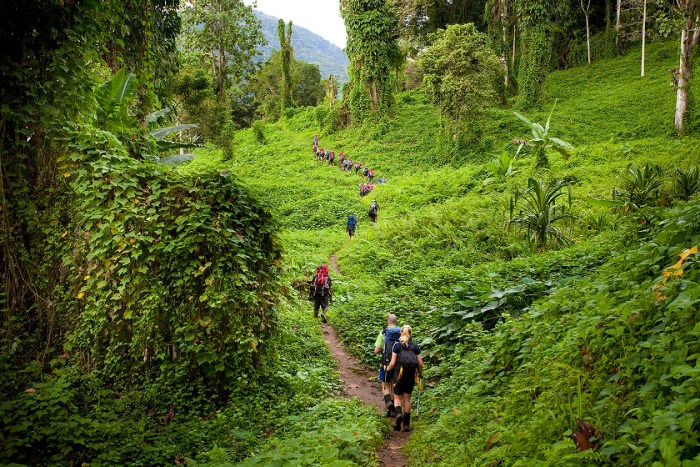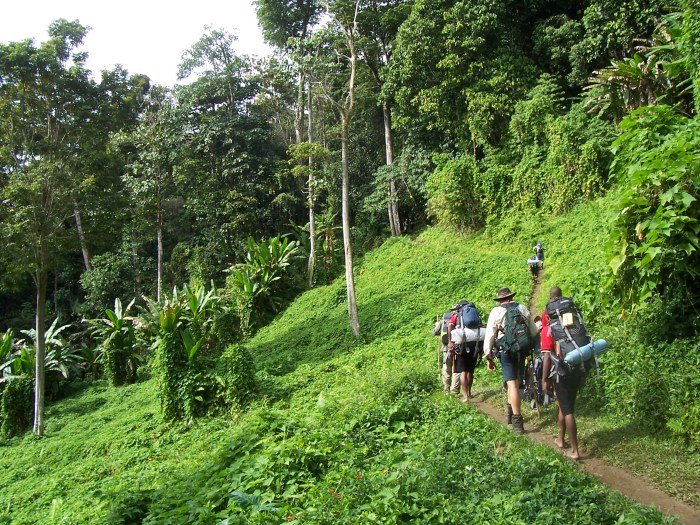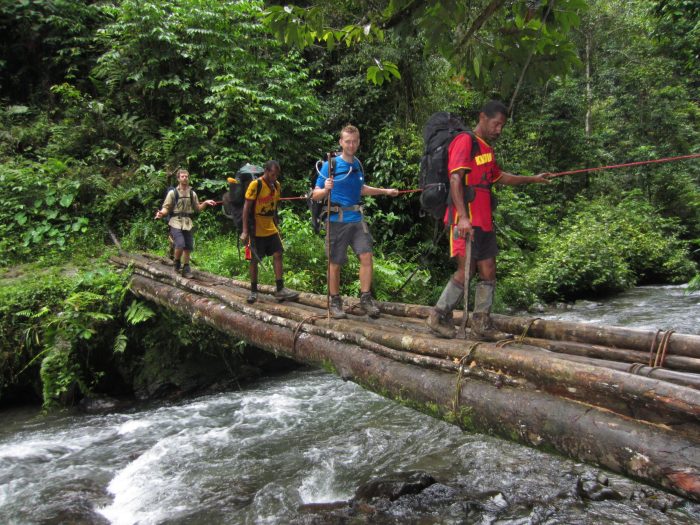Where Is The Kokoda Trail? Nestled in the rugged mountains of Papua New Guinea, the Kokoda Trail is a legendary 96-kilometer (60-mile) track that winds through dense rainforests, over steep ridges, and across crystal-clear rivers. This iconic trail holds immense historical significance, having been the site of fierce battles during World War II, and continues to captivate hikers with its breathtaking scenery and rich cultural heritage.
Prepare to embark on an extraordinary journey as we delve into the fascinating history, geography, and cultural significance of the Kokoda Trail. Along the way, we’ll explore the unique flora and fauna that call this region home, uncover the challenges and rewards of hiking the trail, and discuss the importance of preserving this natural and cultural treasure for generations to come.
History of the Kokoda Trail

The Kokoda Trail, nestled amidst the rugged Owen Stanley Ranges of Papua New Guinea, holds a pivotal place in the annals of World War II. This arduous 96-kilometer track, winding through dense jungles and treacherous terrain, became a battleground during the fierce campaign between the Allied and Japanese forces from July 1942 to January 1943.
The trail’s significance lies in its strategic location, serving as a vital supply route for the Japanese as they aimed to capture Port Moresby, the capital of Papua New Guinea. The Allied forces, determined to halt the Japanese advance, engaged in a series of fierce battles along the trail, each leaving an enduring mark on the landscape and the lives of those involved.
Key Battles and Events
The Kokoda Trail witnessed several key battles that shaped the course of the campaign. The Battle of Isurava, fought in August 1942, marked the first major clash between the opposing forces. The Japanese initially gained the upper hand, but the Australians managed to repel their advance, demonstrating their resilience and tenacity.
The Battle of Eora Creek, which took place in September 1942, was another pivotal engagement. The Japanese, bolstered by reinforcements, launched a renewed offensive, pushing the Australians back towards Port Moresby. However, the Australians, supported by American and Papuan troops, held their ground and eventually forced the Japanese to retreat.
The Battle of Ioribaiwa, fought in October 1942, marked a turning point in the campaign. The Australians, having received reinforcements and supplies, launched a counter-offensive, driving the Japanese back along the trail. The Battle of Buna-Gona, fought from November 1942 to January 1943, was the final major battle of the Kokoda Trail campaign.
The Allies, with overwhelming air and naval support, eventually captured Buna and Gona, securing their victory in the region.
Location and Geography of the Kokoda Trail: Where Is The Kokoda Trail
The Kokoda Trail is a legendary 96-kilometer (60-mile) hiking trail in Papua New Guinea. It stretches from the northern coast at Owers’ Corner to the southern coast at Kokoda. The trail winds through the rugged Owen Stanley Ranges, traversing dense rainforests, steep mountain passes, and rushing rivers.
Geographical Location
Papua New Guinea is a country located in the southwestern Pacific Ocean. It is divided into two regions: the mainland, which is the eastern half of the island of New Guinea, and the Bismarck Archipelago, which is a group of islands to the northeast.
The Kokoda Trail is located on the mainland, in the province of Central.
Terrain and Challenges
The Kokoda Trail is known for its challenging terrain. The trail is mostly unpaved and often muddy and slippery. It also features several steep climbs and descents, with some sections reaching elevations of over 2,000 meters (6,500 feet). The trail is also home to a variety of insects, leeches, and other wildlife, which can add to the difficulty of the hike.
Flora and Fauna of the Kokoda Trail
The Kokoda Trail boasts an incredibly diverse array of flora and fauna, reflecting the region’s unique ecosystem and rich biodiversity. The lush rainforests, towering mountains, and cascading rivers provide a habitat for a multitude of species, many of which are endemic to the area.
Flora
The Kokoda Trail’s diverse flora includes towering rainforest trees, vibrant orchids, and sprawling ferns. The rainforest canopy is dominated by giant trees, such as the strangler fig and the hoop pine, which provide shelter and sustenance for a wide range of animals.
Nestled in the heart of Papua New Guinea, the Kokoda Trail offers a challenging yet rewarding trekking experience. If you’re looking for more information on this iconic path, you might also be interested in learning about the personal life of Red Hot Chili Peppers frontman, Anthony Kiedis.
From his musical career to his relationship with Anthony Kiedis Wife , there’s much to discover about this enigmatic figure. But returning to our original topic, the Kokoda Trail awaits those who seek an unforgettable adventure amidst stunning natural beauty.
The understory is carpeted with lush ferns, vines, and mosses, creating a dense and humid environment.
Fauna
The Kokoda Trail is home to a rich array of fauna, including marsupials, birds, reptiles, and amphibians. Kangaroos, wallabies, and bandicoots are commonly spotted, while cassowaries, parrots, and pigeons fill the air with their calls. The trail also provides habitat for snakes, lizards, and frogs, adding to the region’s diverse ecosystem.
Conservation Efforts
The Kokoda Trail’s unique ecosystem is facing threats from deforestation, climate change, and invasive species. Conservation efforts are underway to protect the region’s biodiversity and ensure its long-term sustainability. These efforts include the establishment of protected areas, the promotion of sustainable tourism, and the restoration of degraded habitats.
Influence on History and Culture
The environment of the Kokoda Trail has had a profound influence on the history and culture of the area. The rugged terrain and dense vegetation provided both challenges and opportunities for the indigenous peoples who have inhabited the region for centuries.
Nestled amidst the rugged landscapes of Papua New Guinea, the Kokoda Trail beckons adventurous souls. If you’re planning a pilgrimage to this historic path, be sure to visit the Taylor Swift Store for a touch of modern convenience. From trail maps to comfortable gear, the store has everything you need to make your journey unforgettable.
As you traverse the Kokoda Trail, the memories you create will be etched in your heart forever.
The trail’s natural resources, such as food, water, and shelter, were essential for survival and played a role in shaping the local culture.
Cultural Significance of the Kokoda Trail
The Kokoda Trail holds profound cultural significance for the local Papuan people. It traverses the ancestral lands of several tribes, including the Koiari, Korafe, and Orokaiva. For centuries, the trail has served as a vital artery connecting communities, facilitating trade, cultural exchange, and spiritual journeys.
Role in Traditions and Ceremonies
The Kokoda Trail is deeply intertwined with the cultural traditions and ceremonies of the Papuan people. It is believed that the spirits of ancestors reside along the trail, and many rituals and ceremonies are performed to honor them. For example, the Koiari people hold an annual ceremony called the “sing-sing” along the trail, where they perform traditional dances, sing songs, and tell stories.
Way of Life
The Kokoda Trail is also an integral part of the Papuan way of life. It provides access to hunting grounds, gardens, and other resources. The local people have a deep understanding of the trail’s flora and fauna, and they use their knowledge to sustain themselves and their communities.
Impact of Tourism
Tourism has brought increased attention to the Kokoda Trail, but it has also raised concerns about its impact on the region’s cultural heritage. While tourism can provide economic benefits, it can also lead to environmental degradation and cultural erosion. It is important to find ways to manage tourism sustainably so that the Kokoda Trail and its cultural significance can be preserved for future generations.
Hiking the Kokoda Trail
The Kokoda Trail is a challenging but rewarding hike that takes you through some of the most beautiful and historic scenery in Papua New Guinea. The trail is well-maintained and there are a number of tour operators who can help you plan your trip.
However, it is important to be well-prepared before you set out on your hike.
Trail Conditions
The Kokoda Trail is a challenging hike, with steep climbs, muddy trails, and river crossings. The trail is also often wet and humid, so it is important to be prepared for all types of weather conditions.
Recommended Gear
When hiking the Kokoda Trail, it is important to bring the right gear. This includes:
- Hiking boots
- Hiking poles
- Backpack
- Water bottle
- First-aid kit
- Insect repellent
- Sunscreen
- Hat
- Rain gear
Safety Precautions
The Kokoda Trail is a safe hike, but there are some safety precautions that you should take. These include:
- Tell someone your itinerary and when you expect to return.
- Stay on the trail.
- Be aware of your surroundings.
- Drink plenty of water.
- Eat nutritious foods.
- Get enough sleep.
- Listen to your body and take breaks when you need them.
Itinerary, Where Is The Kokoda Trail
The Kokoda Trail is typically hiked in 9-12 days. The following is a suggested itinerary:
- Day 1:Arrive in Port Moresby and transfer to Kokoda.
- Day 2:Hike from Kokoda to Isurava.
- Day 3:Hike from Isurava to Templeton’s Crossing.
- Day 4:Hike from Templeton’s Crossing to Efogi.
- Day 5:Hike from Efogi to Ioribaiwa.
- Day 6:Hike from Ioribaiwa to Myola.
- Day 7:Hike from Myola to Kokoda.
- Day 8:Transfer to Port Moresby.
This is just a suggested itinerary, and you can adjust it to fit your own needs and interests. There are a number of tour operators who can help you plan your trip and provide you with all the necessary gear and support.
The Kokoda Trail is a renowned trekking route located in Papua New Guinea. To ensure a seamless and enjoyable experience during your trek, it’s crucial to be well-informed about the trail’s location and the necessary preparations. For those seeking additional information, consider visiting reputable sources such as Remove Meta Ai From Facebook . This website provides valuable insights and tips to help you plan your Kokoda Trail adventure.
Tourism and Economic Impact

Tourism plays a significant role in the economic development of the Kokoda Trail region. It generates income, creates jobs, and supports local businesses. However, it also presents challenges that need to be carefully managed to ensure the sustainability of the trail and the surrounding communities.
Economic Impact
- Income generation:Tourism is a major source of income for the Kokoda Trail region. Visitors spend money on accommodation, food, transportation, and other services, which benefits local businesses and communities.
- Job creation:Tourism creates jobs in various sectors, including hospitality, transportation, and guiding. These jobs provide income and employment opportunities for local residents.
- Support for local businesses:Tourism supports a wide range of local businesses, including guesthouses, restaurants, and tour operators. These businesses rely on tourism revenue to operate and contribute to the local economy.
Benefits and Challenges of Tourism Development
While tourism offers economic benefits, it also presents challenges that need to be carefully managed. These include:
- Environmental impact:Increased tourism can lead to environmental degradation, such as littering, deforestation, and pollution. It is essential to implement sustainable tourism practices to minimize the negative impact on the environment.
- Cultural impact:Tourism can have a positive or negative impact on local cultures. It is important to respect local customs and traditions and to ensure that tourism activities do not disrupt or exploit the local way of life.
- Overcrowding:Increased tourism can lead to overcrowding, especially during peak season. This can strain local infrastructure and resources and diminish the visitor experience.
Opportunities for Sustainable Tourism Practices
To ensure the sustainability of the Kokoda Trail and its surrounding communities, it is essential to adopt sustainable tourism practices. These include:
- Minimizing environmental impact:Implementing measures to reduce waste, conserve water and energy, and protect biodiversity.
- Respecting local culture:Engaging with local communities, learning about their customs and traditions, and supporting local businesses that preserve cultural heritage.
- Managing visitor numbers:Regulating the number of visitors to the trail to avoid overcrowding and minimize the impact on the environment and local communities.
- Supporting local communities:Ensuring that tourism benefits local communities by providing employment opportunities, supporting local businesses, and investing in community development.
Preservation and Conservation of the Kokoda Trail
The Kokoda Trail holds immense historical, cultural, and environmental significance. Preserving and conserving it for future generations is crucial to safeguard its legacy and ensure its continued enjoyment.
The trail faces several threats, including erosion, deforestation, and pollution. Erosion is caused by heavy rainfall and foot traffic, which can damage the trail’s surface and make it difficult to traverse. Deforestation, driven by logging and agricultural expansion, reduces the trail’s canopy cover, exposing it to the elements and increasing erosion.
Pollution from human activities, such as littering and improper waste disposal, degrades the trail’s environment.
Conservation Efforts
To address these threats, various organizations and initiatives are working to conserve the Kokoda Trail. The Kokoda Track Foundation, a non-profit organization, plays a significant role in trail maintenance, research, and education. The Papua New Guinea government has established the Kokoda Track Authority to oversee the trail’s management and protection.
Conservation efforts focus on reducing erosion, reforestation, and promoting responsible tourism practices. Erosion control measures include constructing drainage systems, using erosion mats, and promoting sustainable trail use. Reforestation efforts involve planting native trees and vegetation to restore the trail’s canopy cover and reduce erosion.
Responsible tourism practices include minimizing waste, adhering to designated trails, and respecting the local environment.
By preserving and conserving the Kokoda Trail, we ensure its continued existence for future generations to experience its historical, cultural, and environmental significance.
Educational and Research Opportunities
The Kokoda Trail offers a unique opportunity for educational and research endeavors. Its historical significance, diverse ecosystem, and cultural heritage make it a living laboratory for studying various disciplines.The trail’s historical battles and their impact on the region provide a rich context for studying military history and strategy.
Researchers can explore the strategic significance of the trail, analyze battle tactics, and investigate the role of local populations during the conflict.Ecologically, the Kokoda Trail traverses diverse habitats, including rainforests, grasslands, and mountain ranges. This biodiversity offers ample opportunities for research on flora and fauna, ecosystem dynamics, and the impact of human activities on the environment.Moreover,
the Kokoda Trail holds significant cultural value for the local communities. Researchers can study traditional practices, beliefs, and customs, gaining insights into the region’s cultural heritage and the relationship between people and their environment.
Educational Programs
Several educational programs and initiatives promote learning and research on the Kokoda Trail. Universities and research institutions offer courses and field studies that focus on the trail’s history, ecology, and culture. Local tour operators also provide guided tours with educational components, allowing visitors to experience the trail’s significance firsthand.
Research Initiatives
Various research projects are underway to further our understanding of the Kokoda Trail. These include studies on the trail’s biodiversity, the impact of tourism on the environment, and the preservation of its cultural heritage. The results of these research efforts contribute to the development of sustainable management practices and conservation strategies for the trail.
Summary

The Kokoda Trail stands as a testament to the resilience of the human spirit, the beauty of the natural world, and the importance of preserving our shared heritage. Whether you’re an avid hiker, a history buff, or simply someone seeking adventure, the Kokoda Trail offers an unforgettable experience that will leave a lasting impression.
So, lace up your boots, pack your bags, and prepare to embark on an extraordinary journey through the heart of Papua New Guinea, where history, nature, and culture intertwine to create an unforgettable tapestry.
Quick FAQs
What is the length of the Kokoda Trail?
The Kokoda Trail is approximately 96 kilometers (60 miles) long.
What is the best time to hike the Kokoda Trail?
The best time to hike the Kokoda Trail is during the dry season, which runs from May to October.
What is the terrain like on the Kokoda Trail?
The terrain on the Kokoda Trail is challenging, with steep climbs, slippery descents, and numerous river crossings.
What wildlife can I expect to see on the Kokoda Trail?
The Kokoda Trail is home to a wide variety of wildlife, including birds, reptiles, and mammals such as the tree kangaroo.